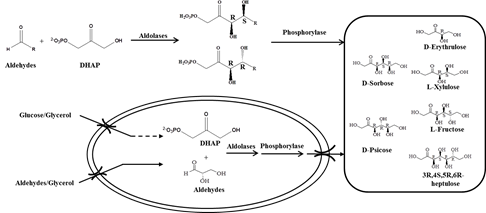Biosynthesis of Rare Sugars Through Constructing a Recombination Pathway in an Engineered Corynebacterium glutamicum
Rare sugars have various biological functions and have been used as food additives, cancer cell suppressors and building blocks for anticancer and antiviral drugs. Because of rare existence of rare sugars in nature, microbial and enzymatic transformations have been developed for synthesis of rare sugars. Prof. Ken Izumori from Kagawa University developed a strategy for preparing all hexoses from cheap and widely available substrates. The aldolases are useful and widely investigated so far in C-C bond formation. Recently, DHAP-dependent aldolases have also been successfully applied to the biosynthesis of carbohydrates and their derivatives. Unlike the rare sugar biosynthesis strategy of Prof. Ken Izumori, which catalyzed the interconversion of monosaccharides, DHAP-dependent aldolases perform the aldol reaction of two micromolecules, DHAP and aldehydes. Furthermore, two new stereocenters would be generated after the aldol reaction. Therefore, it was believed that a series of rare sugars could be synthesized though altering the types of DHAP-dependent aldolase and aldehyde.
The Laboratory of Functional Sugar and Natural Bioactive Products led by Dr. SUN Yuanxia at Tianjin Institute of Industrial Biotechnology (TIB), Chinese Academy of Sciences (CAS) designed and constructed a recombination pathway based on DHAP-dependent aldolases and phosphorylase in C. glutamicum. A wild-type strain harboring this artificial pathway had the ability to produce D-sorbose and D-psicose using D-glyceraldehyde and glucose as the substrates. After additional optimization of expression level of genes in the pathway and of the fermentation conditions, the engineered strain exhibited high efficiency for rare ketoses production. This engineered strain accumulated 19.5 g/L of D-sorbose and 13.4 g/L of D-psicose using a fed-batch culture mode under the optimal conditions. It was also verified that the engineeried strain had the ability to synthesize C4, C5, C6 and C7 rare ketoses when a range of representative achiral and homochiral aldehydes, such as formaldehyde, glycolaldehyde, L-glyceraldehyde and D-erythrose, were applied as the substrates. It was believed that this biosynthesis strategy could be used to synthesize other rare ketoses or deoxysugars with different configurations by altering the type of DHAP-dependent aldolase.
This work was supported by National High Technology Research and Development Program of China (No. 2013AA102105), National Natural Science Foundation of China (General Program, 31371789), Science and Technology Projects of Tianjin (No. KSZD-EW-Z-019). The paper entitled “Biosynthesis of rare ketoses through constructing a recombination pathway in an engineeredCorynebacterium glutamicum” has been published in the journal of Biotechnology and Bioengineering. Dr. YANG Jiangang is the first author of this paper.

In vitro and in vivo synthesis of many rare ketoses based on RhaD aldolase and AP ( Image by SUN Yuanxia’s Group)
